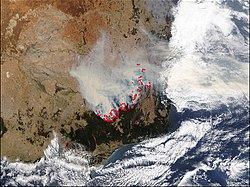A particularly extensive bushfire season in Australia, ran predominantly from December 2002 to March 2003 and involved over 3,000 separate fires in Victoria alone. The 2003 Canberra bushfires were also particularly severe.
Contents
- Overview
- Timeline
- September–November 2002
- December 2002
- January–March 2003
- Aftermath
- Statistics
- Victoria
- References
The developing drought in Australia and well below-average rainfall through winter and spring of 2002 established conditions conducive to above-average bushfire potential. During the 2002–03 season, there were 5,999 bushfires attended by the relevant agency Australia-wide and 7 fatalities, 4 of those from the January Canberra fires.
Perhaps the most well known fire of the season was the Eastern Victorian alpine bushfires that burnt in north-eastern Victoria, the Victorian Alps and Gippsland. This fire was ignited in several locations by multiple lightning strikes and burnt 1.12 million hectares of land over the course of 2 months. Over 15,000 personnel were directly engaged with this fire complex. [1]





